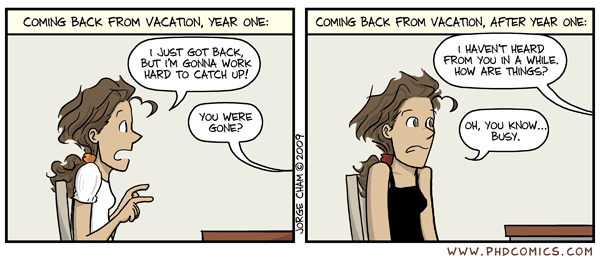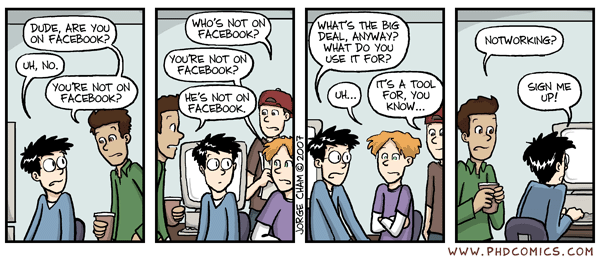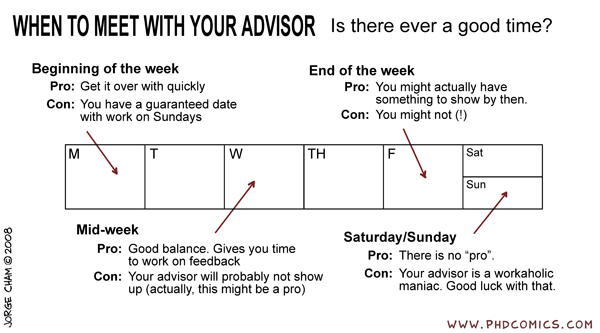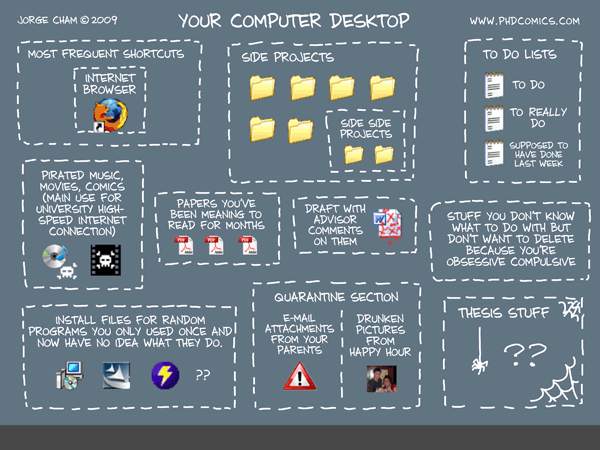It's vacation time!
 Yeah! The long-awaited vacation is just around the corner. Then, I'll leave Malaysia to do an attachment. See you next year! :p
Yeah! The long-awaited vacation is just around the corner. Then, I'll leave Malaysia to do an attachment. See you next year! :p

 Yeah! The long-awaited vacation is just around the corner. Then, I'll leave Malaysia to do an attachment. See you next year! :p
Yeah! The long-awaited vacation is just around the corner. Then, I'll leave Malaysia to do an attachment. See you next year! :p
Busy... seems like the only word I always use to describe my life. lol... I think people are tired of hearing that word from me.
At the end of August, I attended the MSMBB post-conference symposium. After looking at the programme and speaker list, there's no way I can miss this. I was right. Not only did I gain so much knowledge, it's a nice break from my busy life for a couple of days. It gives me new ideas and directions on my work. When I interact with other researchers, I feel very excited about the new things i can do. Enthuasiasm is contagious. I took the advice of the organizer to go home, think about what I wanna do next and write it down. Suddenly, I feel that those few days are so well-spent.
So next time you feel like you can't breathe or what my housemate call "living everyday like a photocopy machine", just take a break to attend a seminar or conference. Go home, think, and write a note.
GRA vacancies at INBIOSIS, UKM
BSc (Honors) in biochemistry, food science or analytic chemistry & >CGPA 3.0 required.Deadline is 8 Sept 09. Please email CV to Dr. Syarul Nataqain nataqain@ukm.my or Dr. Maizom maizom@ukm.my
GRA vacancy at UPM
International conference on Natural Resources and Environmental Management and Environmental Safety and Health 2009
Theme: Understanding the causes and impacts of climate change
Date: 24-26 November 2009
Venue: Hilton Hotel, Kuching, Malaysia
registration fees: RM300 (Student)
KUCHINGGGG!!!!!
MSMBB post-conference seminar on genomics data management
Date: 21 & 22 Aug 2009 (Fri & Sat)
Duration: one and a half day
Venue: Rimba Ilmu, UM
Registration: Rm100
The Malaysian Society for Molecular Biology and Biotechnology (MSMBB), in collaboration with Illumina and Science Vision Sdn Bhd will be organizing the Post Conference Seminar, entitled “The Agri-Genomics Data Management Symposium”, on 21-22nd August 2009 at Rimba Ilmu, University of Malaya. Distinguished speakers from Illumina, Beijing Genomincs Institute, CLC bio, LGM, MGI and Macquarie University (Australia) are invited to share their knowledge and views. A chance not to be missed by local NGS users.
Click here to see the programme. Click here to find out more.
Pesta Konvokesyen ke-37
Date: 12-18 August 2009
Venue: Where else? Dewan Gemilang
Pesta Konvo is back! Food, games, shopping and lepak. It also means that we have to spend money buying gifts for our friends and juniors. It's a tradition. Good thing I only have a short gift list this year. Can't wait to visit the Vegetarian food stall again. Yummy.
I have picked a few activities that sound interesting:
1st ASEAN Sago Symposium 2009
Theme: Current trend and development in Sago research
Date: 29 - 31 Oct 2009
Venue: Riverside Majestic Hotel, Kuching
Sarawak, Malaysia
Click here for more information.
Date: 6 Aug 2009
Time: 8.30 am - 5 pm
Venue: Danau Golf Club, UKM
Registration: RM40
email: ismail@ukm.my/sbp@ukm.my/shadira@ukm.my








Title: Steps to successful research program
Speaker: Dr. Barbara M. Reed (USDA/ARS, Oregon)
Date: 17 July 09 (Friday)
Time: 9am -12 pm
Venue: Bilik Seminar, Inbiosis.

Date: 14 July 09 (Tues)
Venue: Sheraton Imperial Hotel, KL
Time: 8 am - 6 pm
Organizer: BiotechCorp
Theme: Current issues for sustainable research and innovations in microbial biotechnology
Date: 1-4 December 09
Venue: ParkRoyal Hotel, Penang
Open for abstract submission
Click here for more details.
Date: 8 July 09 (Wed)
Time: 11am
Venue: G143
Topics: protein sequence and structure
Speaker: Prof. Peter Artymiuk, University of Sheffield, UK
Hari terbuka FST 2009
Date: 13-15 July 2009
Time: 9 am-5 pm
Venue: Faculty of Science and Technology, UKM
Open to all
FST open day is held in conjunction with FST's 10 years anniversary. This time lotsa cool activities are organized, including school exhibition, research exhibition, visits to Zooloy, Geology musuems and fern park, demonstrations e.g how to make chocolate, health tests, AND jungle trekking in Bangi forest reserve!!! Now, this is exciting. The trip is limited to 30 persons per session.
Click here for more information (BM version only)
Theme: The role of agricultural biotechnology to ensure food security and production in bioenergy in developing countries
Date: 2-5 Nov 09
Venue: KL, Malaysia
Abstract submission deadline: 15 July 09
Student registration fees: RM280/USD 80
Click here for more info.
 One boring afternoon, I decided to go for a walk at KEJUT lake while waiting for PCR. (KEJUT stands for Faculty of Engineering in UKM). That's when I found out that it has a new makeover. New track, new rest place, new Park! The transformation has already attracted a lot of joggers. A fishing competition was even held there last month. I will definitely go there more often after the new semester starts.
One boring afternoon, I decided to go for a walk at KEJUT lake while waiting for PCR. (KEJUT stands for Faculty of Engineering in UKM). That's when I found out that it has a new makeover. New track, new rest place, new Park! The transformation has already attracted a lot of joggers. A fishing competition was even held there last month. I will definitely go there more often after the new semester starts. Read more...
Read more...
UKM Mobility Program (outbound) 2009
Deadline: 31 July 2009
Click here for contact and information
In conjunction with UNESCO World Commission on the Ethics of Scientific Knowledge and Technology (COMEST), a UNESCO-Universiti Kebangsaan Malaysia (UKM) conference will be held to devote the use and management of resources affecting humans and the environment.
Date: 19 June 2009
Venue: Hotel Eastin, Petaling Jaya, Selangor
UKM transport is provided.
No further details from the official website.


 Read more...
Read more...
Biomalaysia- the largest biotechnology conference and exhibition in Malaysia.
Date:17-19 Nov 2009
Venue: Kuala Lumpur Convention Centre
International conference on Oil Palm and the environment
Date: 14-15 August 2009
Venue: Malaysian Agro Exposition Park (MAEP), Serdang (near/within MARDI)
International Palm Oil congress 2009 (PIPOC 2009)
Date: 9-12 Nov 2009
Venue: Kuala Lumpur Convention Centre
For more information, click here.
Really cool sessions on oil palm genome sequencing and biotechnology at PIPOC 2009. What...registration fees RM2,200?! In that case, are you thinking what I'm thinking?! Wahaha *Wicked laugh
Malaysian Palm Oil Board- Graduate Students' Assistantship Scheme (MPOB-GSAS) seminar
Date: 19 June 2009
&
MPOB Transfer of Technology Seminar 2009
Date:18 June 2009
Venue: MPOB HQ, Bangi
Free admission.
Click here for registration.
Date: 15 June 2009 (Mon)
Venue: CGAT, UKM
Registration fees: RM20 (with tea & lunch)
Speaker: Bio-Rad field application specialist
Limited to 30 persons only
Two weeks ago I discovered that my hard disk is shrinking a few Gb each day although I didn't install anything. Disk cleanup and defragmentation didn't solve this problem. I tried to ask around but nobody seems to have this problem. Soon I will run out of hard disk!!! So I did a search online. And my suspicion is real... Vista is the villain. Luckily, I found some great advice at PCSTATS.com. >Beginner guide: Stopping Vista from thrashing hard disk to death.

Seminar Penulisan dan Penerbitan Saintifik 2009 (Agensi Nuklear Malaysia)
Theme: Menyemarak tradisi ilmu
Date: 21-22 July 2009 (Tues & Wed)
Venue: Hotel Cititel, KL.
Organizer: Malaysian Nuclear Agency
Registration fees: RM780
For more information ,click here to download pdf (8Mb).


Ever since I put up the visitor location hit counter a month ago. I have been watching the number of visitors go up beyond my expectation. There has been 153 hits for the past month (an average of 5 visits per day). :-) Very encouraging to me. I wonder if most of the hits come from Pulau Redang and Taman Negara posts. I do hope that the readers can post more comments on the reviews I wrote because I'm not always right. Thanks again for visiting.
Read more...A series of seminars on HEV, Hepatitis B and influenza will be held this week by the School of Biosciences and Biotechnology (PPBsBt) and Malaysia Society of Applied Biology (MAB). The invited speaker is Prof. Dr. Jungsuh Park Kim from Korea University. All are invited.
Title: HEV discovery and beyond
Date: 21 May 2009 (Thurs)
Time: 2.30 pm - 4.00 pm
Venue: Bangunan Biologi FST UKM
Title: Hepatitis C virus drug discovery
Date: 22 May 2009 (Fri)
Time: 9.00 pagi Venue: G143, Bangunan Biologi FST UKM
Title: Influenza: old and new threats
Date: 22 May 2009 (Fri)
Time: 3.00 pm - 5.00 pm
Venue: G143, Bangunan Biologi FST UKM

Oh man, I'm sitting here now at Taipan's Station1 Cafe because I want to use WIFI to submit an abstract. I had to do it before midnight and then...the submission deadline is postponed to 10 days later!!!
I was like What!!! The deadline is still the same when I checked it 6 hours ago. Why didn't they put it up at the website earlier! Geramnya. I should have guessed that most conferences like to do that. Well, I'm glad I have more time to do correction.
Malaysia Toray Science Foundation
Don't tell me you don't know! The Poster was up at Bangunan Biologi main entrance since Jan this year!
MTSF's research grants is open for application each year. It provides total grants up to RM300,000. Qualified young scientists (including postgrad students) are encouraged to compete for the Science and Technology Research Grant. Based on past awards, all recipients received a minimum of RM20,000. Shortlisted candidate will be called for interview. Submission deathline is 31 May 2009.
So don't miss out on this opportunity! Click here for more info.
You can become the next Merck Malaysian Young Scientist 2009. 3 prizes for each category up for grabs. 1st prize winner will receive RM 5,000 cold hard CASH!!!... and a trophy.
Eligiblity:

A novel multiplex solution for quantitative expression analysis
Date: 13 May 2009 (Wednesday)
Time: 10.00 am – 12.30 pm
Venue: Nucleus Block, UKM-MTDC Technology Centre (Malaysia Genome Institute/MGI)
Speaker: Ms Rachel Wang, Application Specialist, Beckman Coulter, Singapore
Seminar on Biosecurity, biodiversity and Plant Genetic Resources
Date: 4 May 2009 (Mon)
Time: 9.30 am -12.30 pm
Venue: Dewan Taklimat, Level 1, Administrative Building, UPM
Speaker: Prof. John Lovett, University of Tasmania
Go to http://www.biotech.upm.edu.my/main/images/news/MOSTIBrochure040509.pdf for more info and registration details. UKM transport will be arranged by Dr. Vani from PPBsBt. Please email vani@pkrisc.cc.ukm.my.
Theme: Harnessing the potential of biodiversity
Date: 17-18 Nov 2009
Venue: Hotel Equatorial, Bangi
Organizer: Department of Biologi, Faculty of Science, UPM
Registration fees: RM400 (Students)/ RM500 (others)
More info on http://www.simbiomas2009.blogspot.com/
Date: 16 May 2009 (Sat)
Time: 8:30 am - 5:00 pm
Venue: Hotel Equatorial, Bangi
Speakers: Profesor Dr. Fredolin Tangang (UKM), Dr. Liew Juneng (UKM), Profesor Dr. Khairulmaini Osman Salleh (UM), Ir.Hj Ahmad Jamaluddin b. Shaaban (NAHRIM), Ling Leong Kwok (MET)
Organizer: ASASI, IKD, KAS
Open registration at www.kesturi.net.


Biocareer fair and exhibition 09
Date: 25 & 26 Apr 09 (Sat & Sun)
Venue: Kuala Lumpur Convention Center
Organizer: Biotech Corp.
Looking for career opportunities in biotechnology? Bring along your resume and other documents to Biocareer 2009. On-site interview will be held.
Title: EndNote workshop
Speaker: Dr. Talib
Date: 22 April 09 (Wed)
Time: 11.30 am
Venue: G139
For 4183 lab members only.
EndNote is a commercial software that can help researchers to manage bibliographies and references when writing journal articles. Trial version can be downloaded from here.
Majlis Syarahan Naib Canselor
Title: Membina momentum menatar keunggulan; Ekosistem Ilmu UKM sebagai Wahana
Date: 17 April 2009
Time: 8.30 am
Venue: DECTAR UKM.
Karnival Komuniti Lestari UKM
Date: 17 April 2009
Time: 9 am - 5 pm
Venue: Panggung Seni, UKM. Just next to DECTAR










© Free Blogger Templates Spain by Ourblogtemplates.com 2008
Back to TOP